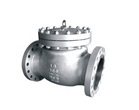- OCTG & Line Pipe
- Fittings
- Flanges
- Valves
- Rig Components & Tools
- Chemical Products
- Glacial Acetic Acid
- Toluene
- Xylene
- Acetone
- Ammonia Water
- Caustic Soda Liquid
- Cyclohexanone
- Dimethylformamide
- Epichlorohydrin
- Ethyl Acetate
- Formaldehyde
- Formic Acid
- Hydrochloric Acid
- Hydrogen Peroxide
- Methanol
- Methyl Ethyl Ketone
- Methyl Isobutyl Ketone
- Methylene Chloride
- N-butyl Acetate
- Nitric Acid
- Phenol
- Sulphuric Acid
- Trichloroethylene
- Personal Protective Equipment
Check Valves
A check valve allows fluid to flow through it in only one direction. Check valves are two-port valves, meaning they have two openings in the body, one for fluid to enter and the other for fluid to leave. There are various types of check valves used in a wide variety of applications. Check valves work automatically and most are not controlled by a person or any external control; accordingly, most do not have any valve handle or stem.

For carbon steel check valves, the seat material is usually forged steel. The sealing surface of the seats is spray welded with hard alloy specified by the customer. Renewable threaded seats are used for NPS<10 check valves, and welded-on seats are optional. Welded-on seats are used for NPS>12 carbon steel gate valves. For stainless steel check valves, an integral seat is usually utilized. Threaded-in or welded-on seats are also optional for stainless steel check valves, if required.
• Body-Cover Gasket
Stainless steel + flexible graphite wounded gaskets are used for Class 150 and Class 300 check valves; stainless steel flexible graphite wounded gaskets are used for Class 600 check valves, a ring type joint gasket is used for Class 900 check valves; a pressure seal design is used for Class 1500 and Class 2500 check valves.
• Body-Cover Connection
The body and bonnet of Class150 to Class 900 check valves are usually connected by with studs and nuts. And the body and bonnet of Class 1500 to Class 2500 check valves usually utilize a pressure seal design.

●Size:
2"-42"●Pressure Rating:
Class 150 / Class 300 / Class 600 / Class 900 / Class 1500 / Class 2500●Material:
WCB/LCB/LCC/WC6/WC9/C5/CF8M/CF8/CF3M/CF3/CN7M●Specifications:
API 600, ASME/ANSI B16.34, BS 1868●End Connection:
RF / RTJ / BW●Design Features:
• SeatFor carbon steel check valves, the seat material is usually forged steel. The sealing surface of the seats is spray welded with hard alloy specified by the customer. Renewable threaded seats are used for NPS<10 check valves, and welded-on seats are optional. Welded-on seats are used for NPS>12 carbon steel gate valves. For stainless steel check valves, an integral seat is usually utilized. Threaded-in or welded-on seats are also optional for stainless steel check valves, if required.
• Body-Cover Gasket
Stainless steel + flexible graphite wounded gaskets are used for Class 150 and Class 300 check valves; stainless steel flexible graphite wounded gaskets are used for Class 600 check valves, a ring type joint gasket is used for Class 900 check valves; a pressure seal design is used for Class 1500 and Class 2500 check valves.
• Body-Cover Connection
The body and bonnet of Class150 to Class 900 check valves are usually connected by with studs and nuts. And the body and bonnet of Class 1500 to Class 2500 check valves usually utilize a pressure seal design.




